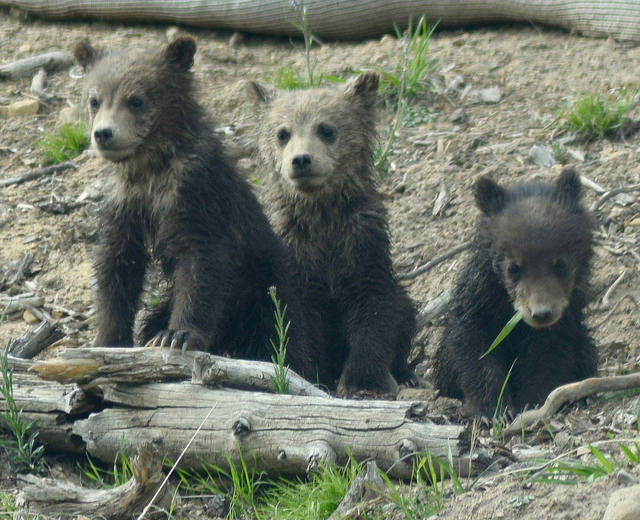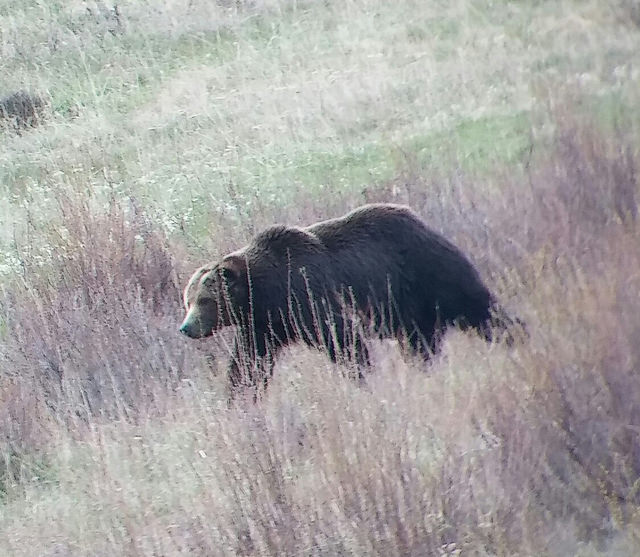
Mid-September, 2016
We’re rolling into Hayden Valley after a satisfying morning of elk bugling in the misty sagebrush plains just outside of Moose. It was a thrilling experience, but that was eight hours ago. As we made our way across the central Yellowstone Plateau, we saw a lot of lodgepole pine trees, but not a single mammal. I can sense my Wildlife Expedition guests wondering when we’re going to get around to the wolves and/or bears part of our “Wolf and Bear Expedition.”
 I had just been in Hayden Valley a few days before, and I know there was a bison carcass on a distant ridge that could potentially give us our first large predator sighting of the day. But at this point, the carcass has been there for two weeks. Even a bison would be largely bones by now. Still, I aim our spotting scopes in the direction of the ridge just as a young visitor utters a wildlife guide’s most dreaded phrase: “Oh, there was a bear there earlier, but you just missed it!”
I had just been in Hayden Valley a few days before, and I know there was a bison carcass on a distant ridge that could potentially give us our first large predator sighting of the day. But at this point, the carcass has been there for two weeks. Even a bison would be largely bones by now. Still, I aim our spotting scopes in the direction of the ridge just as a young visitor utters a wildlife guide’s most dreaded phrase: “Oh, there was a bear there earlier, but you just missed it!”
A few of my guests wait in the car while others help in the search. I pan the landscape with the scope. Ten minutes of searching from a cold and windy pullout can pass very slowly in these days of instant gratification, but the discomfort is forgotten when I catch sight of something moving fast to the south: BEAR!!!
 It’s a large dark grizzly, almost black in color, several miles away. It must be a boar to be that large. He’s moving fast, but two of my guests manage to get a good look at him before he slips out of view behind the hill. Rats. Maybe he’ll show up again.
It’s a large dark grizzly, almost black in color, several miles away. It must be a boar to be that large. He’s moving fast, but two of my guests manage to get a good look at him before he slips out of view behind the hill. Rats. Maybe he’ll show up again.
And he does, approaching the old bison carcass. At this point, all of my guests are at the scopes and are able to get a good look at him. Hooray! By now the crowd is large, and there are around two dozen people milling around my guests and their scopes, most without even binoculars, and all of who want to see the bear. Some are even shoving themselves between my guests and the scopes. I am torn between the joy of sharing a view of a distant animal through a spotting scope, the fact that my guests have paid for this experience, and the possibility that these may be the only grizzlies we see on the trip. (And they were!) To ensure that my guests get as long and good a look as they like, I firmly corral the strangers and tell them that if my guests lose interest they can use a scope. I pass around my expensive personal binoculars as a compromise, praying that no one walks off with them.
 Suddenly one of my guests shouts, “There’s another bear!” A sow. Her camouflage is so perfect; we had been looking at her THE ENTIRE TIME and had no idea she was there. We can only see her when she moves. To our surprise and delight, she charges the boar, even though he is almost twice her size. Soon, we see the reason for the unexpected defensive behavior: one, two, three young cubs. What a mother bear she must be, to have all three of her cubs survive the many dangers of Yellowstone all the way through mid-September.
Suddenly one of my guests shouts, “There’s another bear!” A sow. Her camouflage is so perfect; we had been looking at her THE ENTIRE TIME and had no idea she was there. We can only see her when she moves. To our surprise and delight, she charges the boar, even though he is almost twice her size. Soon, we see the reason for the unexpected defensive behavior: one, two, three young cubs. What a mother bear she must be, to have all three of her cubs survive the many dangers of Yellowstone all the way through mid-September.
The conflict goes on for twenty minutes. The boar retreats and returns, the sow charges multiple times, and the cubs pop up on their hind legs to get a better view. Every one of my five guests is able to observe this incredible, if distant, behavior. Knowing that we still have a lot of ground to cover to get to Cooke City by nightfall, we have to leave eventually. Although there are many more exciting wildlife moments later that weekend, including far closer looks at black bears, our experience with the distant grizzlies gives us our first taste of the wildness and power of Yellowstone National Park.
All photos by Sarah Ernst. Video by Ana Fernandez.


